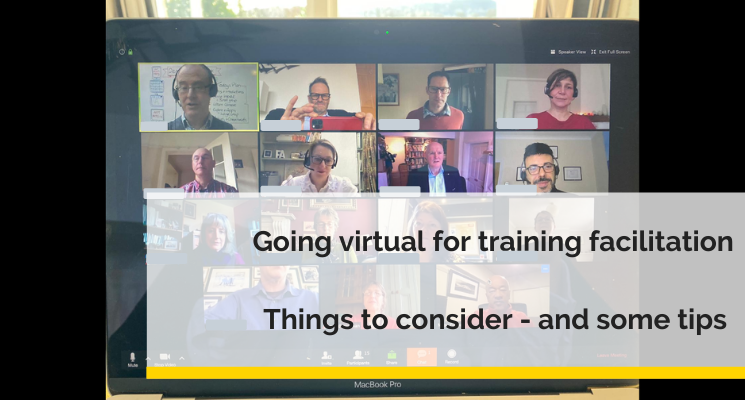Going virtual for training facilitation Things to consider and some tips

Virtual facilitation of training programs is currently in high demand. The outbreak of the Corona virus in numerous countries and the related travel restrictions made companies looking for alternatives to face-to-face trainings. As a trainer, I´m receiving more and more requests of changing the common class-room setting into a virtual one. Being somebody that loves the direct contact with participants, however, I´ve been very critical with “going virtual”. So, I had a closer look at the medium and checked what is really in for participants as well as facilitators, and what we need to take care of if we want to create a successful “virus free” training event.
Going virtual definitely makes sense for various reasons:
· In case of virus outbreaks or other conditions that demand to limit direct human contact going virtual gives a great opportunity to still interact with people and keep the business going.
· It is budget friendly and time saving, too. Not to speak of the reduced stress that traveling (rushing to airports or train stations, checking in and out at hotels, moving between time zones) usually brings along.
· Not to forget: Less air travel reduces CO2-emissions and keeps our planet healthy.
However, there are some things that we need to consider when moving our face-to-face event to a virtual session. Because let´s be honest: A virtual learning experience, no matter how technological advanced or trending it might be at the moment, is not the same as meeting people in a real-life setting.
A taste of how difficult a virtual setting can be is shown by the comedian duo Trip & Tyler in this video, have a look:
[embed]https://youtu.be/JMOOG7rWTPg[/embed]
(Yes, at the end there is an ad but this is not sponsored content. Hope you get the message though.)
The challenge of creating an authentic virtual classroom
For me and my colleague trainers I see two major challenges:
1. As a facilitator it is essential to get a feeling for your participants and to be able to feel the energy of the group. Training is working with human beings. It is about developing skills and leveraging potentials of people, about raising awareness for certain topics and stimulate learning processes, very often with the aim to make people getting better at something or changing behavior. And humans bring emotions along that they express through uncountable signs of body language and mime. The question is: How to create a lasting learning experience if the virtual setting literally demands all people involved to just sit in front of a monitor and communicate only through audio and video?
2. A good training is a training that engages people and keeps them interactive. Good learning programs live from the exchange between people, may this happen in exercises while working on concrete questions or while having an informal chat with someone during a coffee break talk. Question here is, how to make this happen in a virtual setting?
The critical point here is that what multimedia psychologists call the social presence in the virtual room.
Social presence is the degree to which a communication partner is perceived as a natural person with all the body signs like mime, intonation and general appearance that are used to communicate. It gives information about how well a medium is able to transfer social cues to convey intimacy in order to build relationships and trust between users.
Create the right virtual setting
So, how do we make sure that the social presence in our virtual classroom setting is as high as possible? After having been part of successful as well as unsuccessful virtual facilitation, I´m sharing some tips here:
1. Use video: When working with people online, there is nothing worse than talking to a letter icon or profile picture instead of a real person in front of a camera. It is so important that people can see each other faces and read mime and movements, at least to a certain degree.
2. Use a headset to ensure good audio quality. It can be really hard to identify the voice of a person speaking out of an orchestra of echo…
3. Choose a virtual platform that offers various channels of communication, i.e. a chat box or hand signs, and that gives opportunity do group work in breakout rooms. At least, everybody should be able to share their screen, and it is even better if there is something like a virtual pin board where you can stick notes or memos. Make sure that everybody has the software in place to join the chosen platform before the event.
4. Nothing goes without a good and high-speed internet connection.
These points should not only be a recommendation. I even say that all parties involved should insist on fulfilling these technical standards. The target is to increase the social presence of the session in order to be able to deliver a training that makes a difference for the participants. And this is what we want, no matter as a facilitator, participant or company, don’t we?
As a last point: Personally, I believe you cannot remodel every face-to-face learning event to become virtual. However, if we use the tools modern technology offers by keeping the aim for a high social presence in mind, then a virtual session can become a great learning experience.
Feel free to share your thoughts or experiences, I´d be happy to hear from you

Silke is the founder of Culturenergy and serves the global business world as trainer, coach and facilitator. She supports professionals to develop a Global Mindset as well as the skills needed in order to create effective global leadership and thriving spirits in diverse teams. As a German Psychologist and Intercultural Expert she is based in Indonesia for more than 15 years and is Focal Point for here we are global
